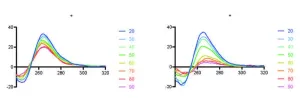(Press-News.org) A genomic study of human and selected nonhuman primate centromeres has revealed their unimaginable diversity and speed of evolutionary change.
In cell genetics, a centromere is the spot where two sister chromatids attach. A chromatid is one-half of a duplicated chromosome. United pairs of chromosomes have identifiable shapes because centromeres are not in a uniform position. As a cell prepares to divide, the machinery to separate and segregate chromosomes goes into action at each centromere location.
Unless the genetic material is distributed correctly between the two resulting cells, problems can arise. These include cancer, congenital disorders such as Down syndrome, and the inability of a fertilized cell to grow into a baby.
Although centromeres are vital to proper cell replication, the complexity of their genomic organization had been almost impossible to study. The lack of centromere sequences hindered exploration of how these regions help maintain genetic integrity.
Today, advances in long-read genome sequencing technologies, refined computerized genome assembly algorithms, and improved genome databases are enabling scientists to realize how greatly centromeres differ in size and structure. This opens new avenues toward figuring out what these differences might mean.
A first look at the factors behind the vast variations in centromeres is reported today, April 3, in Nature. The findings suggest that centromeres are likely highly individualized among people. A set of centromeres might even be a personal signature, just as we each have characteristic voice patterns, iris colorations and fingerprints that distinguish us from one another.
It’s not yet known if certain centromere variations might make people susceptible to particular diseases.
Only the human X chromosome appears to be mostly immutable, with very similar sequences and structure across a diversity of humans.
The lead author of the Nature report is Glennis Logsdon, a recent postdoctoral scholar in Evan Eichler’s genomic science lab at the University of Washington School of Medicine in Seattle. Logsdon is now a faculty member at the Perelman School of Medicine at the University of Pennsylvania. Eichler, who is also a Howard Hughes Medical Institute Investigator and a member of the Brotman Baty Institute for Precision Medicine, is the senior and corresponding author.
“This recent research is a direct application of both the Human Pangenome Reference Consortium and the Telomere-to-Telomere (T2T) sequencing efforts to provide new biological insights into complex regions of the human genome critical for chromosome segregation,” noted Eichler. He is known for his work on genome evolution and its potential to create new functions and also for studies of genetic instability associated with disease.
To capture information on how human centromeres might have evolved, the team compared human genetic sequences of two completely sequenced human centromeres with those of some nonhuman primates. These were the chimpanzee and the orangutan, which are great apes and closely related species to humans, and the macaque, an Old World monkey and a more distant relative.
The scientists discovered that centromeres have been evolving much faster than other unique portions of the human genome. They are among the most mutation-prone regions of the human genome. The researchers also found that the unique sequences and structure of centromeres were the culmination of different evolutionary forces moving at different rates.
“The rapid mutation of the centromeric regions of the genome, along with their various mutation rates, has led to their diverse structure and organization,” Logsdon noted. It was surprising to learn, the scientists said, that such vital areas of the genome were subject to swift changes, because, in general, critical functions tend to be genetically conserved.
The scientists plan to expand these initial efforts by developing more genetic maps of centromeres in diverse human genomes and across various organs and tissues, and to perform multigeneration family studies of centromere sequences. The complete sequence of centromeres from other nonhuman primates will provide a better model of the evolutionary forces shaping these regions.
Peering into the future, Logsdon and her team hope someday to apply their findings on centromeres to the design and engineering of customized human artificial chromosomes to transform medical science. Several years ago, Logsdon and her mentors worked on efforts to develop human artificial chromosomes that bypass centromeric DNA, which had then posed a constraint to mammalian synthetic genome research. Logsdon and others recently published another study last week in Science, which showed that enlarging the artificial chromosome DNA vector allowed for efficient formation of human artificial chromosomes in cells.
The centromere studies reported today were supported by funding from the National Institutes of Health National Human Genome Research Institute (R01 HG010169); National Institute of General Medical Sciences (K99 GM147352 ); National Cancer Institute (R01 CA266339); Intramural Research Program of the National Human Genome Research Institute; Shanghai Jiao Tong University 2030 Program (WH510363001-7); Center for Integration in Science of the Ministry of Aliyah, Israel; and the Howard Hughes Medical Institute. This work utilized the computational resources of the National Institutes of Health High Performance Computing Biowulf Linux cluster.
END
Study gives first view of centromere variation and evolution
Critical for accurate transmission of chromosomes during cell division, centromeres differ vastly in size, structure and epigenetic makeup.
2024-04-03
ELSE PRESS RELEASES FROM THIS DATE:
New tools reveal how genes work and cells organize
2024-04-03
Proteins binding to RNA are important in many processes in the cell and can mediate a range of biological functions. A specialized structure in both DNA and RNA, the G-quadruplex, are regulatory elements involved in gene expression in both DNA and RNA. In the present work the researchers use theoretical predictions and molecular biology experiments to show that many chromatin-binding proteins bind to RNA G-quadruplexes. With this information they can classify proteins based on their potential to bind RNA G-quadruplexes.
The study uses a combination of experimental identification of RNA G-quadruplex-binding proteins and computational methods to build a prediction tool that identify the probability ...
New study shows LLMs respond differently based on user’s motivation
2024-04-03
A new study recently published in the Journal of the American Medical Informatics Association (JAMIA) reveals how large language models (LLMs) respond to different motivational states. In their evaluation of three LLM-based generative conversational agents (GAs)—ChatGPT, Google Bard, and Llama 2, PhD student Michelle Bak and Assistant Professor Jessie Chin of the School of Information Sciences at the University of Illinois Urbana-Champaign found that while GAs are able to identify users' ...
Top multiple sclerosis neurologists & scientists to headline CMSC Annual Meeting for healthcare professionals
2024-04-03
The leading research and educational conference for multiple sclerosis healthcare professionals in North America, the Consortium of Multiple Sclerosis Centers (CMSC) 38th Annual Meeting, returns to Nashville, Tennessee, May 29-June 1, 2024 at the Music City Center. The conference is renowned for its emphasis on reaching the interprofessional team involved in MS care, with learning opportunities for physicians, advanced practice clinicians, nursing professionals, pharmacists, mental health and rehabilitation specialists, dietitians, researchers, advocates and other members of the healthcare team involved in the management of people with MS.
...
Novel fabrication technique takes transition metal telluride nanosheets from lab to mass production
2024-04-03
Transition metal telluride nanosheets have shown enormous promise for fundamental research and other applications across a rainbow of different fields, but until now, mass fabrication has been impossible, leaving the material as something of a laboratory curiosity rather than an industrial reality. But a team of researchers has recently developed a novel fabrication technique—the use of chemical solutions to peel off thin layers from their parent compounds, creating atomically thin sheets—that looks set to finally deliver on the ultra-thin substance's promise.
The researchers describe their fabrication technique in a study published in Nature on April 3.
In ...
Two Jurassic mammaliaforms from China shed light on mammalian evolution
2024-04-03
Mammaliaforms are extinct and extant organisms that are closely related to mammals. Studying mammaliaforms helps scientists understand the evolutionary processes that led to various mammalian features.
In two consecutive studies in Nature, Dr. MAO Fangyuan and Dr. ZHANG Chi from the Institute of Vertebrate Paleontology and Paleoanthropology (IVPP) of the Chinese Academy of Sciences, together with colleagues from Australia and the United States, recently reported two Jurassic mammaliaforms from China, revealing the earliest dental diversification, mandibular middle ears, and articular-quadrate joint transformation of mammaliaforms.
The ...
Socioecologic factors and racial differences in breast cancer prognostic scores
2024-04-03
About The Study: The findings of this study suggest that the consequences of structural racism extend beyond inequities in health care to drive disparities in breast cancer outcome. Additional research is needed with more comprehensive social and environmental measures to better understand the influence of social determinants on aggressive estrogen receptor-positive tumor biology among racial and ethnic minoritized women from disadvantaged and historically marginalized communities.
Authors: Gregory S. Calip, Pharm.D., M.P.H., Ph.D., of the University of Southern California in Los Angeles, is the corresponding author.
To access the embargoed study: ...
Disparities in mentorship and implications for surgical resident education and wellness
2024-04-03
About The Study: In a survey study of residents of all accredited general surgery programs, one-third of trainees reported lack of meaningful mentorship, particularly non-white or Hispanic trainees. Although education and wellness are multifactorial issues, mentorship was associated with improvement; thus, efforts to facilitate mentorship are needed, especially for minoritized residents.
Authors: Yue-Yung Hu, M.D., M.P.H., of Northwestern University in Chicago, is the corresponding author.
To access the embargoed study: Visit our For The Media website at this link ...
Intelligent liquid
2024-04-03
Researchers from the Harvard John A. Paulson School of Engineering and Applied Sciences (SEAS) have developed a programmable metafluid with tunable springiness, optical properties, viscosity and even the ability to transition between a Newtonian and non-Newtonian fluid.
The first-of-its-kind metafluid uses a suspension of small, elastomer spheres — between 50 to 500 microns — that buckle under pressure, radically changing the characteristics of the fluid. The metafluid could be used in everything ...
New Sylvester study targets major risk factor for gastric cancer
2024-04-03
MIAMI, FLORIDA (April 3, 2024) – What if we could eliminate a major risk factor for stomach cancer in Black, Asian, Latino and other vulnerable populations? A new study from Sylvester Comprehensive Cancer Center at the University of Miami Miller School of Medicine shows the feasibility of reaching out to high-risk communities with free, accessible testing and treatment for Helicobacter pylori bacterium infection – a major risk factor for gastric cancer.
Shria Kumar, M.D., a physician-scientist at Sylvester, sees patients with gastric cancer in her ...
New Jurassic fossil findings provide insights into the development of the middle ear in mammals
2024-04-03
New Jurassic fossil findings provide insights into the development of the middle ear in mammals
An international team of palaeontologists has made a significant discovery in fossils that offer key information about the evolutionary shift from the jaw joint bones to those of the middle ear in early mammals.
The findings published today in the prestigious journal Nature provide a clearer insight into the evolution of hearing in mammaliaforms.
The fossils, from the Jurassic Period, are of two different ...
LAST 30 PRESS RELEASES:
iPS cells from dish to freezer and back
Deep neural networks enable accurate pricing of American options under stochastic volatility
Collective risk resonance in Chinese stock sectors uncovered through higher-order network analysis
Does CPU impact systemic risk contributions of Chinese sectors? Evidence from mixed frequency methods with asymmetric tail long memory
General intelligence framework to predict virus adaptation based on a genome language model
Antibiotic resistance is ancient, ecological, and deeply connected to human activity, new review shows
Vapes, pouches, heated tobacco, shisha, cigarettes: nicotine in all forms is toxic to the heart and blood vessels
From powder to planet: University of Modena engineers forge a low-carbon future for advanced metal manufacturing
Super strain-resistant superconductors
Pre-school health programme does not improve children’s diet or physical activity, prompting call for policy changes, study finds
Autumn clock change linked to reduction in certain health conditions
AI images of doctors can exaggerate and reinforce existing stereotypes
Where medicine meets melody – how lullabies help babies and parents in intensive care
We may never be able to tell if AI becomes conscious, argues philosopher
AI video translation shows promise but humans still hold the edge
Deep ocean earthquakes drive Southern Ocean’s massive phytoplankton blooms, study finds
Without campus leftovers to pick through, the beaks of this bird changed shape during the pandemic
High-dose antibiotic does not reduce mortality in tuberculous meningitis
How many insects fly in the sky above the USA?
Could cheese protect your brain health?
Who faces more difficulty recovering from stroke?
Colliding galaxies create the brightest, fastest growing black holes at their center
New BrainHealth research reveals tradeoffs on sleep with cannabis use for chronic pain
Aging-US now on ResearchGate, enhancing visibility for authors and readers
'Molecular glue' stabilizes protein that inhibits development of non-small cell lung cancer
Mount Sinai Health System is recognized in 2025 Chime Digital Health Most Wired survey
From prey to predator: How carnivores spread beneficial fungi
Menopause symptoms may be frequent and have negative effects, according to female endurance athletes
US Congressmembers’ responses on X to mass shooting events differ along party lines
KAIST-UEL team develops “origami” airless wheel to explore lunar caves
[Press-News.org] Study gives first view of centromere variation and evolutionCritical for accurate transmission of chromosomes during cell division, centromeres differ vastly in size, structure and epigenetic makeup.





